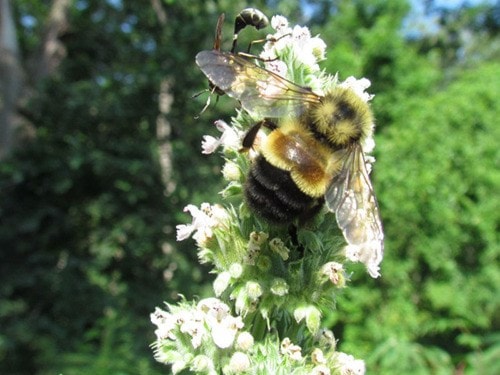Without bees, where would we be? When our sweet tooth isn’t calling, we pretty much take these fuzzy little guys for granted. But if we didn’t have bees to pollinate our crops, look out.
What would life be like without them?
“There’d be a third less food on the shelf, and our food selection would be diminished drastically,” says John Gibeau, who teaches commercial beekeeping at Kwantlen Polytechnic University in Cloverdale. “There’d probably be food fights in the stores.”
Not the fun kind, either.
Last week there was a huge buzz, pardon the pun, in major U.S. newspapers and magazines about the Rusty Patched Bumble Bee (Bombus affinis) being added to that country’s list of endangered species.
In Canada, this species is found in parts of Ontario, where it was listed as endangered in 2010, and Quebec where it was listed as threatened or vulnerable that same year.
It’s the first bumble bee to be declared endangered in the U.S., National Geographic reports, with its population declining by 87 per cent over the past 20 years.
“This Bumble Bee Species In Danger of Disappearing Forever,” Time magazine’s headline warns.
It’s always tragic when any species becomes extinct – except maybe spiders, he he. Seriously, though, when it comes to bees, endangerment is big news. Bumble bees, even more than honey bees, are great pollinators.
According to the National Resource Defence Council, an international team of agriculture experts found that 87 types of crops worldwide need animal pollinators whereas only 28 can survive without their help. Without bees and other pollinators, say goodbye to almonds. Coffee would be precious. Apples, onions, avocados and many types of berries would become scarce.
Grapes, tomatoes, cranberries, broad beans, blueberries, blackberries, eggplant, raspberries, boysenberries, black currants, pears and pomegranates are pollinated by bees. So are potatoes, cashews, celery, strawberries, beets, mustard, broccoli, cauliflower, cabbage, turnips, brussels sprouts, canola, peppers, papayas, chestnuts, coconuts, oranges, grapefruits, chestnuts, watermelon, cantaloupe, cucumber, squash, pumpkins and zucchinis.
Not to mention lemons, limes, carrots, beans, flax, cotton, fennel, apricots, peaches, cherries, plums, and, well, you get the picture.
One of the things U.S. President Barack Obama’s administration did on its way out was to increase protection for the Rusty Patched Bumble Bee by having the Fish and Wildlife Service designate it an endangered species.
Gibeau, looking at the situation glass-half-full, says this is good news because a byproduct of the designation should mean more bee habitat will be preserved.
“I think it’s pre-emptive,” he says. “I don’t think it’s reached a crisis.”
As well as being an instructor at Kwantlen, Gibeau is president of Surrey’s Honeybee Centre, at Fraser Highway and 176th Street, and co-founded the Bee World Project. He noted that without indigenous bees, farmers might eventually have to resort to importing Africanized bees, also known as Killer Bees, to pollinate their crops. Horror movies have been made about those guys.
Meantime, Dr. Margriet Dogterom, an expert in blueberry pollination and founder of Beediverse in Coquitlam, says she has hasn’t seen a Bombus occidentalis, or Western Bumble Bee, “for probably over 10 years now.”
“Something is happening,” she said. “This is terrible stuff.”
Dogterom noted most plants require external pollination. “We cannot do without bees,” she said. “They are our pollinators.”
tom.zytaruk@thenownewspaper.com
